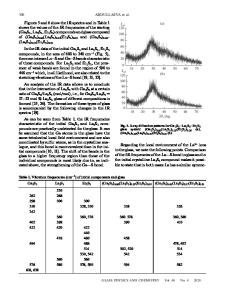Phase equilibria in the BaS-Ln 2 S 3 systems
- PDF / 358,487 Bytes
- 6 Pages / 612 x 792 pts (letter) Page_size
- 3 Downloads / 355 Views
Basic and Applied Research: Section I
Phase Equilibria in the BaS-Ln2S3 Systems O.V. Andreev, P.V. Miodushevscy, R. Serlenga, and N.N. Parsukov
(Submitted May 9, 2002; in revised form December 15, 2004) A survey of available data for the BaS2-Ln2S3 systems shows that the very light lanthanon systems form no intermediate phases but have extensive terminal solid solubilities of BaS in ␥-Ln2S3 extending to near 50 mol.% BaS. For Ln = Nd and for all heavier lanthanons (smaller 3+ ionic radii, rLn ), an intermediate phase with stoichiometry of BaLn2S4 is formed. BaLn2S4 decomposes peritectoidally for Ln = Nd but melts congruently for Ln = Sm and for all heavier lanthanons. A second intermediate phase of stoichiometry, Ba3Ln2S6, forms for Ln = Tb and for all heavier lanthanons (smaller ionic radii). For Ln = Lu, a third phase is formed at BaLu8S13. In all cases, Ba3Ln2S6 melts peritectically, but BaLu8S13 melts congruently. The present article discusses: (1) three different techniques for synthesizing the intermediate phases; (2) the systems for Ln = Pr, Tb, and Y; and (3) a computer model for interpolating through the available data for the phase relationships in the nine systems that have been investigated to predict the phase diagrams for the seven systems for which there are limited or no data.
1. Introduction In 1968, Flahaut and Laruelle[1] surveyed the available data for ternary combinations of the lanthanide elements with sulfur (S), selenium (Se), or tellurium (Te) plus a third element. In the 1990s, Andreev and coworkers[2-4] determined the pseudobinary phase diagrams of the Bas-Ln2S3 systems with Ln ⳱ lanthanum (La), neodymium (Nd), samarium (Sm), gadolinium (Gd), erbium (Er), and lutetium (Lu). In the course of the present investigation, the BaSLn2S3 systems with Ln ⳱ praseodymium (Pr), terbium (Tb), and yttrium (Y) were determinned to make a total of nine BaS-Ln2S3 systems with known phase equilibria. The present article presents (a) information on the preparation of the materials, (b) the methods for determining the phase diagrams, and (c) interpolation among the data for the known phase equilibria for the nine systems that have been investigated to predict the probable phase equilibria for the seven systems that have not yet been determined. Such prediction is a reasonable thing to do because other lanthanon series are known to exhibit systematic variations with progression from element to element.
2. Materials Preparation 2.1 General Specimens for the study of phase equilibria in the BaSLn2S3 systems can be synthesized by three essentially different methods: (1), by passing a gaseous combination of H2S and CS2 through a bed of solid particles of oxides or salts; (2), by direct combination of the component sulfides; and (3), by direct reaction of the constituent elements. All methods involve mixtures of solid particles, so the kinetics of reaction involve temperature, particle size, thoroughness
of mixing, and distribution of the Ba and Ln cations in the particles. The Ba-to-Ln ratio in the input mixtu
Data Loading...











